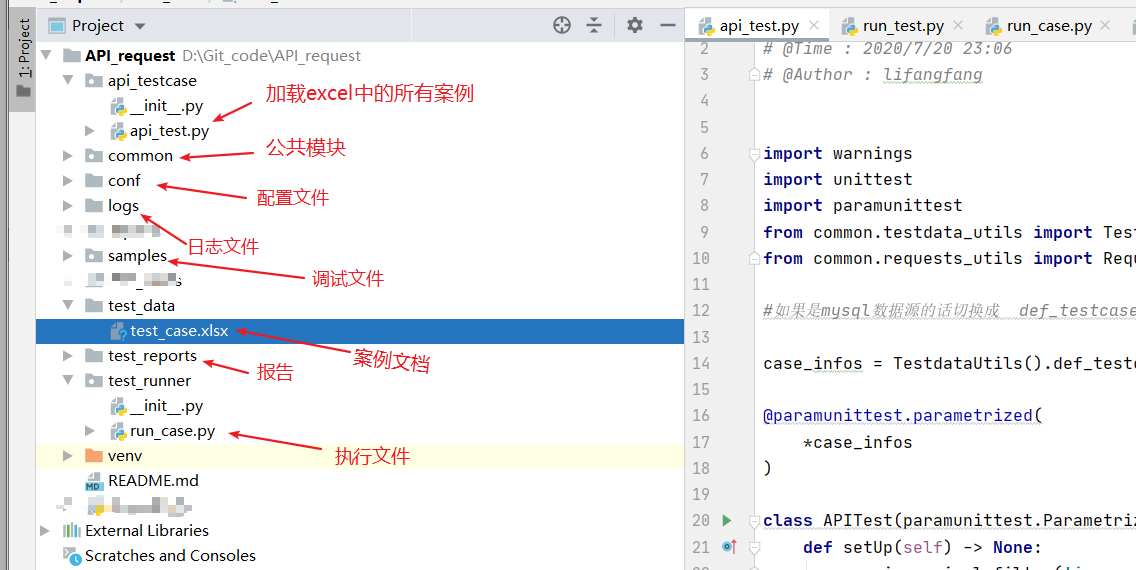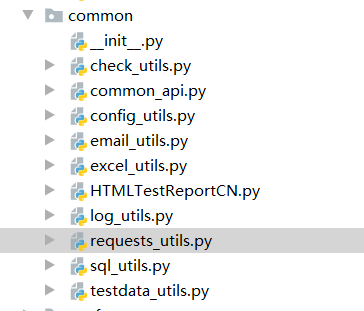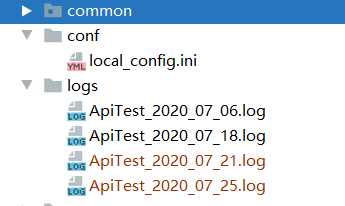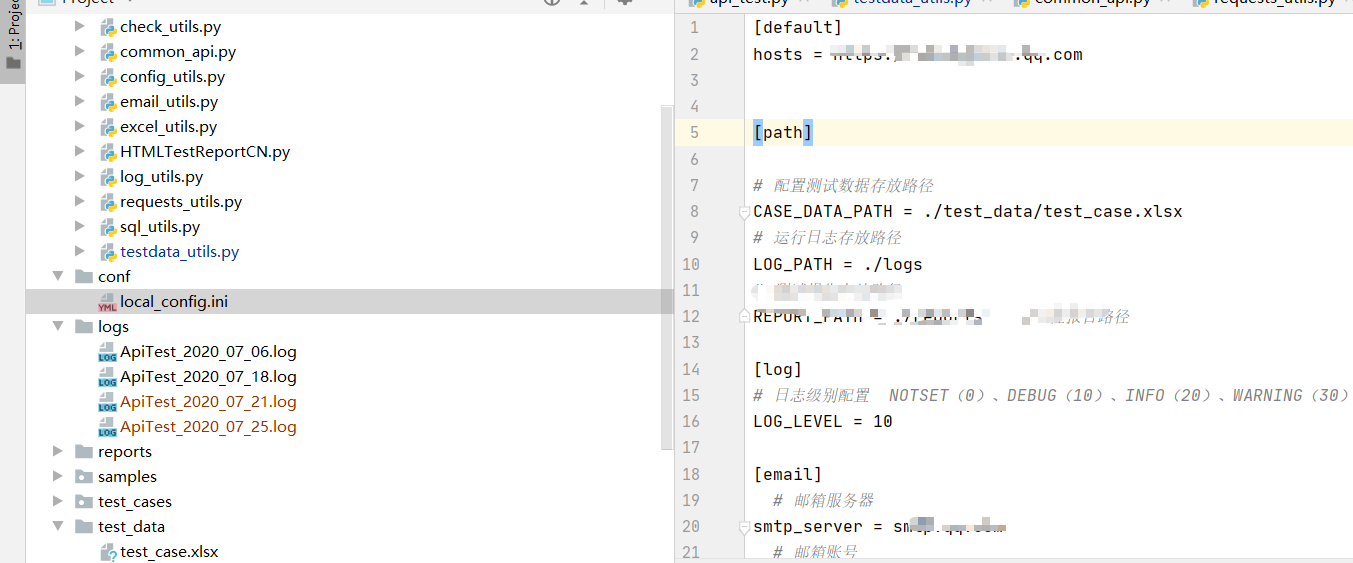一、框架菜单
1.1 common模块
1.2 其他
二、Excel接口测试案例编写
三、读取Excel测试封装(核心封装)
excel_utils.py 读取Excel中的数据
import os
import xlrd #内置模块、第三方模块pip install 自定义模块
class ExcelUtils():
def __init__(self,file_path,sheet_name):
self.file_path = file_path
self.sheet_name = sheet_name
self.sheet = self.get_sheet() # 整个表格对象
def get_sheet(self):
wb = xlrd.open_workbook(self.file_path)
sheet = wb.sheet_by_name(self.sheet_name)
return sheet
def get_row_count(self):
row_count = self.sheet.nrows
return row_count
def get_col_count(self):
col_count = self.sheet.ncols
return col_count
def __get_cell_value(self,row_index, col_index):
cell_value = self.sheet.cell_value(row_index,col_index)
return cell_value
def get_merged_info(self):
merged_info = self.sheet.merged_cells
return merged_info
def get_merged_cell_value(self,row_index, col_index):
\"\"\"既能获取普通单元格的数据又能获取合并单元格数据\"\"\"
cell_value = None
for (rlow, rhigh, clow, chigh) in self.get_merged_info():
if (row_index >= rlow and row_index < rhigh):
if (col_index >= clow and col_index < chigh):
cell_value = self.__get_cell_value(rlow, clow)
break; # 防止循环去进行判断出现值覆盖的情况
else:
cell_value = self.__get_cell_value(row_index, col_index)
else:
cell_value = self.__get_cell_value(row_index, col_index)
return cell_value
def get_sheet_data_by_dict(self):
all_data_list = []
first_row = self.sheet.row(0) #获取首行数据
for row in range(1, self.get_row_count()):
row_dict = {}
for col in range(0, self.get_col_count()):
row_dict[first_row[col].value] = self.get_merged_cell_value(row, col)
all_data_list.append(row_dict)
return all_data_list
if __name__==\'__main__\':
current_path = os.path.dirname(__file__)
excel_path = os.path.join( current_path,\'..\',\'samples/data/test_case.xlsx\' )
excelUtils = ExcelUtils(excel_path,\"Sheet1\")
for row in excelUtils.get_sheet_data_by_dict():
print( row )
import os
from common.excel_utils import ExcelUtils
from common.config_utils import config
current_path = os.path.dirname(__file__)
test_data_path = os.path.join( current_path,\'..\', config.CASE_DATA_PATH )
class TestdataUtils():
def __init__(self,test_data_path = test_data_path):
self.test_data_path = test_data_path
self.test_data = ExcelUtils(test_data_path,\"Sheet1\").get_sheet_data_by_dict()
self.test_data_by_mysql = SqlUtils().get_mysql_test_case_info()
def __get_testcase_data_dict(self):
testcase_dict = {}
for row_data in self.test_data:
testcase_dict.setdefault( row_data[\'测试用例编号\'],[] ).append( row_data )
return testcase_dict
def def_testcase_data_list(self):
testcase_list = []
for k,v in self.__get_testcase_data_dict().items():
one_case_dict = {}
one_case_dict[\"case_id\"] = k
one_case_dict[\"case_info\"] = v
testcase_list.append( one_case_dict )
return testcase_list
if __name__==\"__main__\":
testdataUtils = TestdataUtils()
for i in testdataUtils.def_testcase_data_list():
print( i )
testdata_utils.py 读取Excel中的数据后处理成需要的数据
四、request封装(核心封装)
requests_utils.py 包含post请求,get请求,异常,调用断言
import ast
import re
import requests
import jsonpath
from requests.exceptions import RequestException
from requests.exceptions import ProxyError
from requests.exceptions import ConnectionError
from common.config_utils import config
from common.check_utils import CheckUtils
class RequestsUtils():
def __init__(self):
self.hosts = config.hosts
self.headers = {\"ContentType\":\"application/json;charset=utf-8\"}
self.session = requests.session()
self.temp_variables = {}
def __get(self,get_info):
try:
url = self.hosts + get_info[\"请求地址\"]
response = self.session.get( url = url,
params = ast.literal_eval(get_info[\"请求参数(get)\"])
)
response.encoding = response.apparent_encoding
if get_info[\"取值方式\"] == \"json取值\":
value = jsonpath.jsonpath( response.json(),get_info[\"取值代码\"] )[0]
self.temp_variables[ get_info[\"传值变量\"] ] = value
elif get_info[\"取值方式\"] == \"正则取值\":
value = re.findall(get_info[\"取值代码\"],response.text)[0]
self.temp_variables[get_info[\"传值变量\"]] = value
result = CheckUtils(response).run_check(get_info[\'期望结果类型\'], get_info[\'期望结果\'])
except ProxyError as e:
result = {\'code\': 4, \'result\': \'[%s]请求:代理错误异常\' % (get_info[\"接口名称\"])}
except ConnectionError as e:
result = {\'code\': 4, \'result\': \'[%s]请求:连接超时异常\' % (get_info[\"接口名称\"])}
except RequestException as e:
result = {\'code\': 4, \'result\': \'[%s]请求:Request异常,原因:%s\' % (get_info[\"接口名称\"], e.__str__())}
except Exception as e:
result = {\'code\':4,\'result\':\'[%s]请求:系统异常,原因:%s\'%(get_info[\"接口名称\"],e.__str__())}
return result
def __post(self,post_info):
try:
url = self.hosts + post_info[\"请求地址\"]
response = self.session.post( url = url,
headers = self.headers,
params = ast.literal_eval(post_info[\"请求参数(get)\"]),
# data = post_infos[\"提交数据(post)\"],
json=ast.literal_eval(post_info[\"提交数据(post)\"])
)
response.encoding = response.apparent_encoding
if post_info[\"取值方式\"] == \"json取值\":
value = jsonpath.jsonpath( response.json(),post_info[\"取值代码\"] )[0]
self.temp_variables[ post_info[\"传值变量\"] ] = value
elif post_info[\"取值方式\"] == \"正则取值\":
value = re.findall(post_info[\"取值代码\"],response.text)[0]
self.temp_variables[post_info[\"传值变量\"]] = value
#调用CheckUtils()
result = CheckUtils(response).run_check(post_info[\'期望结果类型\'],post_info[\'期望结果\'])
except ProxyError as e:
result = {\'code\': 4, \'result\': \'[%s]请求:代理错误异常\' % (post_info[\"接口名称\"])}
except ConnectionError as e:
result = {\'code\': 4, \'result\': \'[%s]请求:连接超时异常\' % (post_info[\"接口名称\"])}
except RequestException as e:
result = {\'code\': 4, \'result\': \'[%s]请求:Request异常,原因:%s\' % (post_info[\"接口名称\"], e.__str__())}
except Exception as e:
result = {\'code\':4,\'result\':\'[%s]请求:系统异常,原因:%s\'%(post_info[\"接口名称\"],e.__str__())}
return result
def request(self,step_info):
try:
request_type = step_info[\"请求方式\"]
param_variable_list = re.findall(\'\\\\${\\w+}\', step_info[\"请求参数(get)\"])
if param_variable_list:
for param_variable in param_variable_list:
step_info[\"请求参数(get)\"] = step_info[\"请求参数(get)\"]\\
.replace(param_variable,\'\"%s\"\' % self.temp_variables.get(param_variable[2:-1]))
if request_type == \"get\":
result = self.__get( step_info )
elif request_type == \"post\":
data_variable_list = re.findall(\'\\\\${\\w+}\', step_info[\"提交数据(post)\"])
if data_variable_list:
for param_variable in data_variable_list:
step_info[\"提交数据(post)\"] = step_info[\"提交数据(post)\"] \\
.replace(param_variable, \'\"%s\"\' % self.temp_variables.get(param_variable[2:-1]))
result = self.__post( step_info )
else:
result = {\'code\':1,\'result\':\'请求方式不支持\'}
except Exception as e:
result = {\'code\':4,\'result\':\'用例编号[%s]的[%s]步骤出现系统异常,原因:%s\'%(step_info[\'测试用例编号\'],step_info[\"测试用例步骤\"],e.__str__())}
return result
def request_by_step(self,step_infos):
self.temp_variables = {}
for step_info in step_infos:
temp_result = self.request( step_info )
# print( temp_result )
if temp_result[\'code\']!=0:
break
return temp_result
if __name__==\"__main__\":
case_info = [
{\'请求方式\': \'get\', \'请求地址\': \'/cgi-bin/token\', \'请求参数(get)\': \'{\"grant_type\":\"client_credential\",\"appid\":\"wxXXXXXxc16\",\"secret\":\"XXXXXXXX\"}\', \'提交数据(post)\': \'\', \'取值方式\': \'json取值\', \'传值变量\': \'token\', \'取值代码\': \'$.access_token\', \'期望结果类型\': \'正则匹配\', \'期望结果\': \'{\"access_token\":\"(.+?)\",\"expires_in\":(.+?)}\'},
{\'请求方式\': \'post\', \'请求地址\': \'/cgi-bin/tags/create\', \'请求参数(get)\': \'{\"access_token\":${token}}\', \'提交数据(post)\': \'{\"tag\" : {\"name\" : \"衡东\"}}\',\'取值方式\': \'无\', \'传值变量\': \'\', \'取值代码\': \'\', \'期望结果类型\': \'正则匹配\', \'期望结果\': \'{\"tag\":{\"id\":(.+?),\"name\":\"衡东\"}}\'}
]
RequestsUtils().request_by_step(case_info)
五、断言封装(核心封装)
check_utils.py 断言封装,与实际结果核对
import re
import ast
class CheckUtils():
def __init__(self,check_response=None):
self.ck_response=check_response
self.ck_rules = {
\'无\': self.no_check,
\'json键是否存在\': self.check_key,
\'json键值对\': self.check_keyvalue,
\'正则匹配\': self.check_regexp
}
self.pass_result = {
\'code\': 0,
\'response_reason\': self.ck_response.reason,
\'response_code\': self.ck_response.status_code,
\'response_headers\': self.ck_response.headers,
\'response_body\': self.ck_response.text,
\'check_result\': True,
\'message\': \'\' # 扩招作为日志输出等
}
self.fail_result = {
\'code\': 2,
\'response_reason\': self.ck_response.reason,
\'response_code\': self.ck_response.status_code,
\'response_headers\': self.ck_response.headers,
\'response_body\': self.ck_response.text,
\'check_result\': False,
\'message\': \'\' # 扩招作为日志输出等
}
def no_check(self):
return self.pass_result
def check_key(self,check_data=None):
check_data_list = check_data.split(\',\') #把需要判断的值做切割,取出键值
res_list = [] #存放每次比较的结果
wrong_key = [] #存放比较失败key
for check_data in check_data_list: #把切割的键值和取出响应结果中的所有的键一个一个对比
if check_data in self.ck_response.json().keys():
res_list.append(self.pass_result )
else:
res_list.append( self.fail_result )
wrong_key.append(check_data) #把失败的键放进来,便于后续日志输出
# print(res_list)
# print(wrong_key)
if self.fail_result in res_list:
return self.fail_result
else:
return self.pass_result
def check_keyvalue(self,check_data=None):
res_list = [] # 存放每次比较的结果
wrong_items = [] # 存放比较失败 items
for check_item in ast.literal_eval(check_data).items(): #literal_eval()安全性的把字符串转成字典,items()取出键值对
if check_item in self.ck_response.json().items():
res_list.append( self.pass_result )
else:
res_list.append( self.fail_result )
wrong_items.append(check_item)
# print( res_list )
# print( wrong_items )
if self.fail_result in res_list:
return self.fail_result
else:
return self.pass_result
def check_regexp(self,check_data=None):
pattern = re.compile(check_data)
if re.findall(pattern=pattern,string=self.ck_response.text): #匹配到了,不为空,为true
return self.pass_result
else:
return self.fail_result
def run_check(self,check_type=None,check_data=None):
code = self.ck_response.status_code
if code == 200:
if check_type in self.ck_rules.keys():
result=self.ck_rules[check_type](check_data)
return result
else:
self.fail_result[\'message\'] = \'不支持%s判断方法\'%check_type
return self.fail_result
else:
self.fail_result[\'message\'] = \'请求的响应状态码非%s\'%str(code)
return self.fail_result
if __name__==\"__main__\":
# 检查键是否存在,{\"access_token\":\"hello\",\"expires_\":7200} 设为响应结果,\"access_token,expires_in\" 为检查对象值
CheckUtils({\"access_token\":\"hello\",\"expires_\":7200}).check_key(\"access_token,expires_in\")
#检查键值对是否存在
CheckUtils({\"access_token\":\"hello\",\"expires_i\":7200}).check_keyvalue(\'{\"expires_in\": 7200}\')
#正则对比
#TURE
print(CheckUtils(\'{\"access_token\":\"hello\",\"expires_in\":7200}\').check_regexp(\'\"expires_in\":(.+?)\'))
#False
print(CheckUtils(\'{\"access_token\":\"hello\",\"expires\":7200}\').check_regexp(\'\"expires_in\":(.+?)\'))
六、api_testcase下的api_test.py 封装
import warnings
import unittest
import paramunittest
from common.testdata_utils import TestdataUtils
from common.requests_utils import RequestsUtils
#如果是mysql数据源的话切换成 def_testcase_data_list_by_mysql() exccel数据源:def_testcase_data_list()
case_infos = TestdataUtils().def_testcase_data_list_by_mysql()
@paramunittest.parametrized(
*case_infos
)
class APITest(paramunittest.ParametrizedTestCase):
def setUp(self) -> None:
warnings.simplefilter(\'ignore\', ResourceWarning) #不会弹出警告提示
def setParameters(self, case_id, case_info):
self.case_id = case_id
self.case_info = case_info
def test_api_common_function(self):
\'\'\'测试描述\'\'\'
self._testMethodName = self.case_info[0].get(\"测试用例编号\")
self._testMethodDoc = self.case_info[0].get(\"测试用例名称\")
actual_result = RequestsUtils().request_by_step(self.case_info)
self.assertTrue( actual_result.get(\'check_result\'),actual_result.get(\'message\') )
if __name__ == \'__main__\':
unittest.main()
七、common下的log_utils.py 封装
import os
import logging
import time
from common.config_utils import config
current_path = os.path.dirname(__file__)
log_output_path = os.path.join( current_path,\'..\', config.LOG_PATH )
class LogUtils():
def __init__(self,log_path=log_output_path):
self.log_name = os.path.join( log_output_path ,\'ApiTest_%s.log\'%time.strftime(\'%Y_%m_%d\') )
self.logger = logging.getLogger(\"ApiTestLog\")
self.logger.setLevel( config.LOG_LEVEL )
console_handler = logging.StreamHandler() # 控制台输出
file_handler = logging.FileHandler(self.log_name,\'a\',encoding=\'utf-8\') # 文件输出
formatter = logging.Formatter(\"%(asctime)s %(name)s %(levelname)s %(message)s\")
console_handler.setFormatter(formatter)
file_handler.setFormatter(formatter)
self.logger.addHandler( console_handler )
self.logger.addHandler( file_handler )
console_handler.close() # 防止打印日志重复
file_handler.close() # 防止打印日志重复
def get_logger(self):
return self.logger
logger = LogUtils().get_logger() # 防止打印日志重复
if __name__ == \'__main__\':
logger.info(\'hello\')
八、common下的config_utils.py的封装
配置文件的编写:
对配置文件的读取封装:
import os
import configparser
current_path = os.path.dirname(__file__)
cfgpath = os.path.join(current_path, \"../conf/local_config.ini\")
print(cfgpath)
class ConfigUtils:
def __init__(self,config_path=cfgpath):
self.__conf=configparser.ConfigParser()
self.__conf.read(config_path, encoding=\"utf-8\")
def read_ini(self,sec,option):
value=self.__conf.get(sec,option)
return value
@property
def hosts(self):
value=self.read_ini(\'default\',\'hosts\')
return value
@property
def LOG_PATH(self):
value = self.read_ini(\'path\', \'LOG_PATH\')
return value
@property
def CASE_DATA_PATH(self):
value = self.read_ini(\'path\', \'CASE_DATA_PATH\')
return value
@property
def REPORT_PATH(self):
value = self.read_ini(\'path\', \'REPORT_PATH\')
return value
@property
def LOG_LEVEL(self):
value = int(self.read_ini(\'log\', \'LOG_LEVEL\'))
return value
@property
def smtp_server(self):
smtp_server_value = self.read_ini(\'email\', \'smtp_server\')
return smtp_server_value
@property
def smtp_sender(self):
smtp_sender_value = self.read_ini(\'email\', \'smtp_sender\')
return smtp_sender_value
@property
def smtp_password(self):
smtp_password_value = self.read_ini(\'email\', \'smtp_password\')
return smtp_password_value
@property
def smtp_receiver(self):
smtp_receiver_value = self.read_ini(\'email\', \'smtp_receiver\')
return smtp_receiver_value
@property
def smtp_cc(self):
smtp_cc_value = self.read_ini(\'email\', \'smtp_cc\')
return smtp_cc_value
@property
def smtp_subject(self):
smtp_subject_value = self.read_ini(\'email\', \'smtp_subject\')
return smtp_subject_value
config=ConfigUtils()
if __name__==\'__main__\':
current_path = os.path.dirname(__file__)
cfgpath = os.path.join(current_path, \"../conf/local_config.ini\")
config_u=ConfigUtils()
print(config_u.hosts)
print(config_u.LOG_LEVEL)
九、test_runner下的run_case.py 封装
class RunCase():
def __init__(self):
self.test_case_path = test_case_path
self.report_path = test_report_path
self.title = \'P1P2接口自动化测试报告\'
self.description = \'自动化接口测试框架\'
self.tester = \'测试开发组\'
def load_test_suite(self):
discover = unittest.defaultTestLoader.discover(start_dir=self.test_case_path,
pattern=\'api_test.py\',
top_level_dir=self.test_case_path)
all_suite = unittest.TestSuite()
all_suite.addTest( discover )
return all_suite
def run(self):
report_dir = HTMLTestReportCN.ReportDirectory(self.report_path)
report_dir.create_dir(self.title)
report_file_path = HTMLTestReportCN.GlobalMsg.get_value(\'report_path\')
fp = open( report_file_path ,\'wb\' )
runner = HTMLTestReportCN.HTMLTestRunner(stream=fp,
title=self.title,
description=self.description,
tester=self.tester)
runner.run( self.load_test_suite() )
fp.close()
return report_file_path
if __name__==\'__main__\':
report_path = RunCase().run()
EmailUtils(open(report_path, \'rb\').read(), report_path).send_mail()
十、common下的email_utils.py 封装
import os
import smtplib
from email.mime.text import MIMEText
from email.mime.multipart import MIMEMultipart
from common.config_utils import config
class EmailUtils():
def __init__(self,smtp_body,smtp_attch_path=None):
self.smtp_server = config.smtp_server
self.smtp_sender = config.smtp_sender
self.smtp_password = config.smtp_password
self.smtp_receiver = config.smtp_receiver
self.smtp_cc = config.smtp_cc
self.smtp_subject = config.smtp_subject
self.smtp_body = smtp_body
self.smtp_attch = smtp_attch_path
def mail_message_body(self):
message = MIMEMultipart()
message[\'from\'] = self.smtp_sender
message[\'to\'] = self.smtp_receiver
message[\'Cc\'] = self.smtp_cc
message[\'subject\'] = self.smtp_subject
message.attach( MIMEText(self.smtp_body,\'html\',\'utf-8\') )
if self.smtp_attch:
attach_file = MIMEText(open(self.smtp_attch, \'rb\').read(), \'base64\', \'utf-8\')
attach_file[\'Content-Type\'] = \'application/octet-stream\'
attach_file.add_header(\'Content-Disposition\', \'attachment\', filename=(\'gbk\', \'\', os.path.basename(self.smtp_attch)))
message.attach(attach_file)
return message
def send_mail(self):
smtp = smtplib.SMTP()
smtp.connect(self.smtp_server)
smtp.login(user=self.smtp_sender, password=self.smtp_password)
smtp.sendmail(self.smtp_sender,self.smtp_receiver.split(\",\")+ self.smtp_cc.split(\",\"), self.mail_message_body().as_string())
if __name__==\'__main__\':
html_path = os.path.dirname(__file__) + \'/../test_reports/接口自动化测试报告V1.1/接口自动化测试报告V1.1.html\'
EmailUtils(\'<h3 align=\"center\">自动化测试报告</h3>\',html_path).send_mail()
以上就是本文的全部内容,希望对大家的学习有所帮助,也希望大家多多支持自学编程网。



















